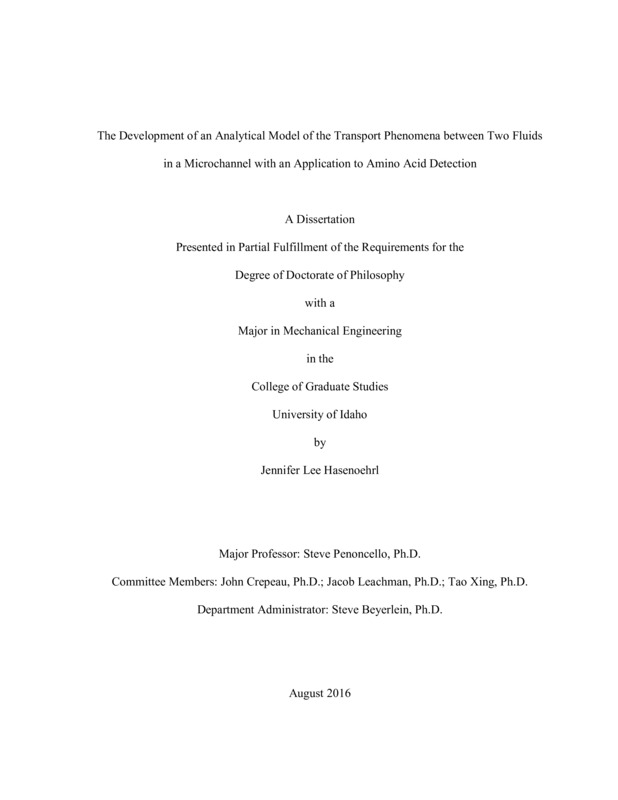The Development of an Analytical Model of the Transport Phenomena between Two Fluids in a Microchannel with an Application to Amino Acid Detection
Hasenoehrl, Jennifer Lee. (2016). The Development of an Analytical Model of the Transport Phenomena between Two Fluids in a Microchannel with an Application to Amino Acid Detection. Theses and Dissertations Collection, University of Idaho Library Digital Collections. https://www.lib.uidaho.edu/digital/etd/items/hasenoehrl_idaho_0089e_10730.html
- Title:
- The Development of an Analytical Model of the Transport Phenomena between Two Fluids in a Microchannel with an Application to Amino Acid Detection
- Author:
- Hasenoehrl, Jennifer Lee
- Date:
- 2016
- Embargo Remove Date:
- 2017-01-29
- Keywords:
- fluorescamine laminar flow diffusion interface microchannel design molecular diffusion transport phenomena
- Program:
- Mechanical Engineering
- Subject Category:
- Mechanical engineering
- Abstract:
-
A transport model for the fluid flow of two immiscible fluids in a microchannel is presented. The fluids, water and acetone, are at a Reynolds number of less than 10 to ensure laminar flow during the diffusion portion of the microchannel. Laminar flow provides the means of diffusion of molecules to occur between the fluids without the fluids mixing all while in a microdevice. In this research, amino acids and fluorescamine are carried by the water and acetone, respectively.
The fluid properties as carriers of the molecules are unknown for transport phenomena calculations so best predictions are calculated from diffusion theory and Einstein’s diffusion equation. The diffusion coefficient for fluorescamine (1.77x10-6 cm2/s in acetone and 6.11x10-7 cm2/s in water at 298 K) is compared to the calculated versus manufacturer provided data for fluorescein, a similar fluorophore that gives off light at a differing wavelength.
Thermal effects on the fluids as well as chemical reactions are investigated. The model is validated with experimental results from the literature and experimental measurements taken in lab of fluorescing beads in moving water. Comparison between the model results and literature show an agreement within 10%. This can be attributed to diffusion coefficients and temperature differences within the model. The model predicts diffusion of fluorescamine-tagged amino acids to the acetone side by 1.88 mm of the channel length.
- Description:
- doctoral, Ph.D., Mechanical Engineering -- University of Idaho - College of Graduate Studies, 2016
- Major Professor:
- Penoncello, Steven G
- Committee:
- Crepeau, John; Xing, Tao; Leachman, Jacob
- Defense Date:
- 2016
- Identifier:
- Hasenoehrl_idaho_0089E_10730
- Type:
- Text
- Format Original:
- Format:
- application/pdf
- Rights:
- In Copyright - Educational Use Permitted. For more information, please contact University of Idaho Library Special Collections and Archives Department at libspec@uidaho.edu.
- Standardized Rights:
- http://rightsstatements.org/vocab/InC-EDU/1.0/

